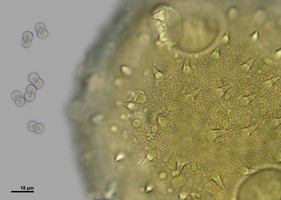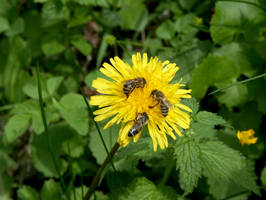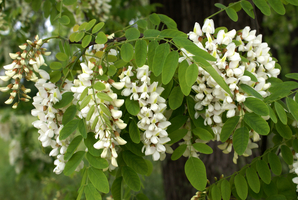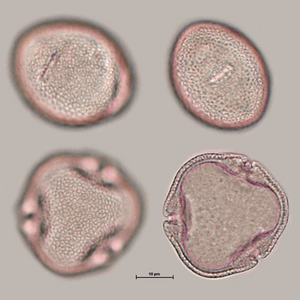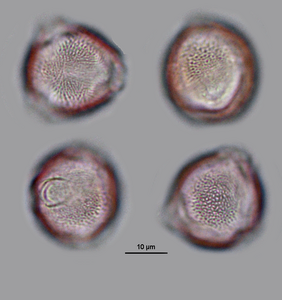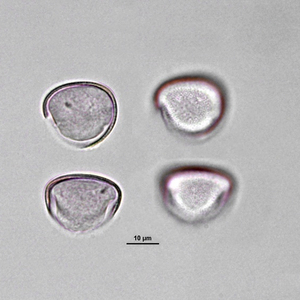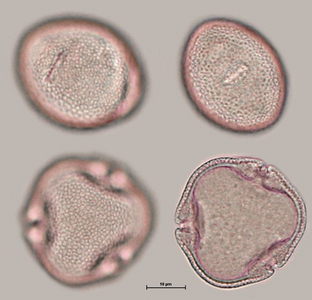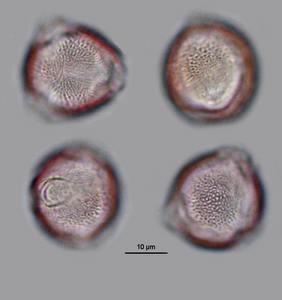Pollen analysis
Thousands of years ago, honey was already called the food of the gods by the ancient Egyptians. But honey is not just honey. It owes its broad spectrum of color, taste, aroma and ingredients to the nectar collected by bees from various flowering plants and honeydew. In order to determine which plants the bees have visited for their honey or which nectar or honeydew they have collected, honey pollen analysis is an indispensable tool.
The honey pollen analysis is the third pillar, besides the sensory and the chemical-physical examination, to determine the geographical origin and varietal purity of a honey. Here the circumstance is used that each plant visited by a bee leaves its fingerprint in the honey in the form of a pollen typical for each plant species. Based on the number or composition of individual pollen, the geographical origin and varietal purity of the honey is inferred.
It is also used to help the beekeeper decide whether to declare the honey as varietal honey, because the honey jar must always contain the type of honey indicated on the label. A false declaration can lead to severe penalties by the food authorities.
How does the pollen get into the nectar or honey?
- Primary dusting: This is the pollen that is introduced into the honey by the bee in the course of nectar collection.
- Secondary pollen: Pollen that falls from the bee into the honeycomb cell through the hair coat or pollen pouches during honey processing.
- Tertiary dusting: pollen grains that enter the honey during centrifugation or, in the case of pressed honey, through bee bread.
By secondary, as well as tertiary dusting no conclusions can be drawn on the Trachtangebot.
The size of a pollen grain ranges from about 5 µm (5 thousandths of a millimeter) to 150 µm (Fig.1). There are about 5000 pollen grains in one gram of honey. However, not every plant leaves the same amount of pollen in the nectar. This depends on the inflorescence of the plant.
If the flower is upright, the pollen falls down into the nectar at the bottom of the flower when touched or blown by the wind and is thus picked up by the bee when collecting nectar (Fig. 2). If it hangs downwards (Fig. 3), most of the pollen falls onto the edge of the flower or out of the flower. This leaves little pollen in the nectar, which is brought into the hive by the bees. One speaks of over- or under-represented plants. This circumstance is taken into account when judging for botanical origin. (Bandion and Pechhacker, 2003 Method book for honey testing in Austria, ISBN 3-200-00072-4).
Basically, there are three different pollen donors:
- Nectar plants: plants that produce nectar and pollen (rape, sunflower, dandelion, etc.).
- Nectarless plants: plants that produce pollen only (plantain, corn, sour grasses, etc.)
- Wind-blooming plants: plants whose pollen is tolerated by the wind and thus gets into the nectar or honeydew (spruce, alder, birch, etc.)
Types of examination
We currently offer three different honey pollen analyses:
Orientational screening: this involves identifying and listing all pollen forms found in the honey. An overview photograph is taken of the honey preparation and all pollen visible in the photograph is identified by name.
Leading pollen analysis: Here all pollen forms found in the honey are identified and 500 pollen are counted. All pollen forms that range in percentage from 3% to 45% and above are listed by percentage. All pollen forms found below 3% in the honey are listed by name. An overview photo of the honey preparation is made and all pollen forms visible on the photo are marked by letters and listed by name in a separate table. Thus the beekeepers get an overview of the pollen forms of their honey and can make them available also to the honey customers.
Full analysis: In the full analysis all pollen forms found in the honey are identified. 1,000 pollen grains are counted according to certain guidelines, listed and listed in percent. From the honey preparation an overview photo is made and all pollen visible on the photo is marked by name (Bandion and Pechhacker, 2003: Methodenbuch zur Honigprüfung in Österreich, ISBN 3-200-00072-4).
All 3 examination methods are promoted via the special guideline beekeeping promotion 2020 - 2022, but must be applied for and charged via the respective provincial association.
The type of honey does not have to correspond to the flower supply perceived by beekeepers.
It is not always necessary to harvest "fruit honey" from an apiary located in an orchard, if the bees prefer to fly over the adjacent rapeseed field or the dandelion growing under the fruit trees, as these are more attractive to the bees in terms of nectar supply. Also, not every sunflower field has to "honey" if sunflower variety and weather do not cooperate.
Preparation of honey samples for pollen analysis
The honey from the storage container should be mixed well and then 250 g of it should be filled into a honey jar. Then send this honey sample to the testing centre:
AGES GmbH
Department of Apiculture and Bee Protection
For the attention of Sarah Oberleitner
Spargelfeldstraße 191
A-1220 Vienna
Tel. +43 50555 33129
The price list for honey analyses can be found in the Downloads section.
Examples of a pollen analysis: AGES honey
Lime blossom honey from the Spargelfeldstraße location (harvest 2024): A full pollen analysis of the honey sample was carried out. All pollen forms were identified, listed and then 1,000 pollen grains were counted. Based on the result of the pollen analysis, the honey with a lime pollen content of 7.8% can be labelled as "lime blossom honey".
In the course of the analysis, a total of 36 different pollen forms were detected in the honey sample. The variety of pollen found makes the honey a typical honey from the north-eastern outskirts of Vienna: the bees collected pollen from the surrounding gardens and parks as well as from the fields of the Marchfeld. The honey therefore contains pollen from various fruit trees, lime trees, maples and lilacs as well as garden asparagus from the surrounding fields. Various pollen from field and roadside herbs, such as different cruciferous plants, composite plants and plantain plants complete the pollen spectrum. According to our pollen expert Sarah Oberleitner, there is also another pollen that makes honey special: "I mainly find pollen from the tree of heaven in Eastern Austrian honeys. This makes the honey typical for Vienna." This wide variety of pollen types makes the honey from Spargelfeldstraße something very special.
With a share of 25.4%, the most common type of pollen comes from the tree of heaven(Ailanthus altissima). The approximately 21-25µm large pollen grain is characterised by its round shape, a furrowed surface and three germination sites, which are formed into pore folds (see illustration).
The pollen that gives honey its name, which comes from lime trees(Tilia sp.), is slightly larger at 21-35µm. The surface is reticulated and the three characteristic germination sites are formed as short pore folds (see illustration).
The pollen of the garden asparagus(Asparagus officinales), which matches the location by name, is round and about 21-25µm in size. The surface structure cannot be clearly determined with a light microscope. The germination site is formed as a fold and is located at the distal pole of the pollen grain (see illustration).
Although the pollen of the tree of heaven is present in a larger proportion than the lime pollen, the honey can still be labelled as lime blossom honey. This is because there is generally less pollen in lime nectar. Lime pollen is therefore underrepresented, which is why a honey can be labelled as lime blossom honey if it contains as little as 1% lime pollen.
Examples of a pollen analysis: AGES honey
Lime blossom honey from the Spargelfeldstraße site (harvest 2023): A full pollen analysis of the honey was carried out. All pollen forms were identified, listed and then 1,000 pollen grains were counted and listed according to frequency. Based on the results of this pollen analysis, the honey can be labelled as blossom honey or, more precisely, as "lime blossom honey".
A total of 44 different pollen forms were detected in our honey sample. The variety of pollen found makes the honey a typical honey from the north-eastern outskirts of Vienna: the bees collected both in the surrounding gardens and parks as well as in the fields of the Marchfeld. The honey therefore contains pollen from fruit trees, lilac, lime and robinia as well as buckwheat and strawberries from the surrounding fields. Various pollen from herbs from the fields and roadside verges complete the pollen spectrum. In keeping with the location address of Spargelfeldstraße, the pollen of garden asparagus is also found in our honey. Just like last year, according to our pollen expert Waltraud Auer, another pollen makes the honey special: "I mainly find pollen from the tree of heaven in Eastern Austrian honeys, which makes the honey typical of Vienna." The many different types of pollen identified make the honey something special.
The most common type of pollen (62.7 %) comes from the tree of heaven (Ailanthus altissima). Description: round pollen about 21-25 µm in size with a furrowed surface. Germination sites are formed as pore folds (see illustration).
Lime pollen (Tilia sp.), the pollen that gives honey its name, was detected with a significantly lower frequency of 5 %. Description: round pollen about 21-35 µm in size with a reticulated surface. Germination sites are formed as folds (see illustration).
But why can the honey be called linden honey despite this low proportion of linden pollen? In principle, the pollen is underrepresented in lime blossom honey - this means that although the honey consists of a high percentage of lime nectar, it contains only a few lime pollen grains. Due to this fact, lime blossom honeys may be labelled as varietal honey if they contain as little as 1 % lime pollen. Furthermore, there is currently no variety description for honey from the tree of heaven in the underlying assessment literature.
Other areas of application
By examining the pollen from the bee's hair coat, the honey stomach and also the pollen pouches, it is possible to determine the plant species last approached. In the case of suspected poisoning, conclusions can be drawn about the origin of active substances used in certain crops.
Furthermore, in the field of paleontology, paleobotany, plant sociology, vegetation dynamics, allergy research (pollen warning service), climate research and criminology. Pollen findings in the gastrointestinal tract of the glacier mummy Ötzi made it possible to narrow down the time of death and the last route.
History of our pollen analysis
In 1992 we started to build up a pollen reference collection at our Institute of Apiculture in Lunz am See and a few years later a digital pollen database (PONET) on the internet, which is freely accessible to everyone. Due to the competence gained in this way, we were able to venture into honey pollen analysis at the beginning of the 2000s, as this requires many years of experience and good knowledge, both of the domestic (in Austria alone there are about 2,500 different vascular plant species) and foreign flora.
In 2021, the pollen database, which contained light microscopic images of about 2,200 different plant species, was merged with the pollen database of AutPal - Verein zur Förderung der palynologischen Forschung in Österreich, Department für Botanik und Biodiversitätsforschung, Abteilung für Strukturelle und Funktionelle Botanik (PalDat), which contained scanning electron microscopic images of about 2,300 different plant species. This resulted in PalDat, one of the largest pollen databases in the world, freely accessible on the Internet.
Last updated: 18.09.2024
automatically translated
